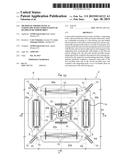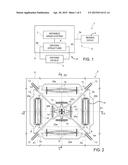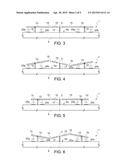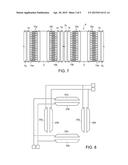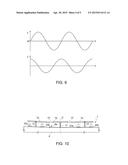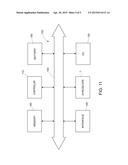Patent application title: MICROELECTROMECHANICAL GYROSCOPE WITH COMPENSATION OF QUADRATURE ERROR DRIFT
Inventors:
Carlo Valzasina (Gessate, IT)
Luca Giuseppe Falorni (Limbiate, IT)
Assignees:
STMicroelectroncs S.r.l.
IPC8 Class: AG01C195712FI
USPC Class:
7350412
Class name: Speed, velocity, or acceleration angular rate using gyroscopic or coriolis effect vibratory mass
Publication date: 2015-04-30
Patent application number: 20150114112
Abstract:
A microelectromechanical gyroscope, includes: a supporting body; a first
movable mass and a second movable mass, which are oscillatable according
to a first driving axis and tiltable about respective a first and second
sensing axes and are symmetrically arranged with respect to a center of
symmetry; first sensing electrodes and a second sensing electrodes
associated with the first and second movable masses and arranged on the
supporting body symmetrically with respect to the first and second
sensing axis, the first and second movable masses being capacitively
coupled to the respective first sensing electrode and to the respective
second sensing electrode, a bridge element elastically coupled to
respective inner ends of the first movable mass and of the second movable
mass and coupled to the supporting body so as to be tiltable about an
axis transverse to the first driving axis.Claims:
1. A microelectromechanical gyroscope, comprising: a supporting body; a
first movable mass configured to oscillate with respect to the supporting
body along a first driving axis and configured to rotate about a first
sensing axis; a second movable mass configured to oscillate with respect
to the supporting body along the first driving axis and configured to
rotate around a second sensing axis; a first sensing electrode and a
second sensing electrode associated with the first movable mass and
arranged on the supporting body symmetrically with respect to the first
sensing axis, the first movable mass being capacitively coupled to the
first sensing electrode and to the second sensing electrode; a third
sensing electrode and a fourth sensing electrode associated with the
second movable mass and arranged on the supporting body symmetrically
with respect to the second sensing axis, the second movable mass being
capacitively coupled to the third sensing electrode and to the fourth
sensing electrode.
2. A gyroscope as claimed in claim 1, further comprising a bridge element elastically coupled to respective inner ends of the first movable mass and of the second movable mass and coupled to the supporting body, the bridge element configured to rotate about an axis transverse to the first driving axis.
3. A gyroscope as claimed in claim 1 wherein the first sensing electrode and the second sensing electrode associated with the first movable mass are arranged within a perimeter of the first sensing mass and the third sensing electrode and the fourth sensing electrode associated with the second movable mass are arranged within a perimeter of the second sensing mass.
4. A gyroscope as claimed in claim 1 wherein the first driving axis, the first sensing axis, and the second sensing axis are parallel to a surface of the supporting body.
5. A gyroscope as claimed in claim 4 wherein the first sensing axis and the second sensing axis are parallel to each other and perpendicular to the first driving axis.
6. A gyroscope as claimed in claim 1 wherein the first movable mass and the second movable mass are symmetrically arranged with respect to a center of symmetry.
7. A gyroscope as claimed in claim 2 wherein the bridge element is configured to bind the first movable mass and the second movable mass to rotate both clockwise or both counter-clockwise.
8. A gyroscope as claimed in claim 1, further comprising: a third movable mass configured to oscillate with respect to the supporting body along a second driving axis and configured to rotate about a third sensing axis; a fourth movable mass configured to oscillate with respect to the supporting body along the second driving axis and configured to rotate about a fourth sensing axis; a fifth sensing electrode and a sixth sensing electrode associated with the third movable mass and arranged on the supporting body symmetrically with respect to the third sensing axis, the third movable mass being capacitively coupled to the fifth sensing electrode and the sixth sensing electrode; and a seventh sensing electrode and an eighth sensing electrode associated with the fourth movable mass and arranged on the supporting body symmetrically with respect to the fourth sensing axis, the fourth movable mass being capacitively coupled to the seventh sensing electrode and the eighth sensing electrode.
9. A gyroscope as claimed in claim 8 wherein the fifth, sixth, seventh, and eighth sensing electrodes are arranged between the supporting body and the respective one of the third movable mass and fourth movable mass.
10. A gyroscope as claimed in claim 8 wherein the fifth and sixth sensing electrodes associated with the third movable mass are arranged within a perimeter of the third sensing mass and the seventh and eighth sensing electrodes associated with the fourth movable mass are arranged within a perimeter of the fourth sensing mass.
11. A gyroscope as claimed in claim 8 wherein the second driving axis is perpendicular to the first driving axis and third and fourth sensing axes are parallel to each other and perpendicular to first and second sensing axes.
12. A gyroscope as claimed in claim 8, further comprising a bridge element elastically coupled to respective inner ends of the first movable mass and of the second movable mass and coupled to the supporting body, the bridge element being elastically coupled to respective inner ends of the third movable mass and of the fourth movable mass and is coupled to the supporting body, the bridge element configured to rotate about an axis transverse to the first driving axis and about an axis transverse to the second driving axis.
13. A gyroscope as claimed in claim 12 wherein the bridge element is configured to bind the third movable mass and the fourth movable mass to rotate both clockwise or both counter-clockwise.
14. A gyroscope according to claim 1, further comprising a driving structure, configured to provide electrostatic driving forces between the supporting body and at least one of the first movable mass and second movable mass in response to driving voltages, thereby causing the first movable mass and second movable mass to move symmetrically in opposite directions along the first driving axis.
15. A gyroscope according to claim 1 wherein the first sensing electrodes and the second sensing electrodes are arranged between the supporting body and the respective one of the first movable mass and second movable mass.
16. An electronic system, comprising: a control unit; a microelectromechanical gyroscope coupled to the control unit, the gyroscope including: a supporting body; a first movable mass configured to oscillate with respect to the supporting body along a first driving axis and configured to rotate about a first sensing axis; a second movable mass configured to oscillate with respect to the supporting body along the first driving axis and configured to rotate around a second sensing axis; a first sensing electrode and a second sensing electrode associated with the first movable mass and arranged on the supporting body symmetrically with respect to the first sensing axis, the first movable mass being capacitively coupled to the first sensing electrode and to the second sensing electrode; a third sensing electrode and a fourth sensing electrode associated with the second movable mass and arranged on the supporting body symmetrically with respect to the second sensing axis, the second movable mass being capacitively coupled to the third sensing electrode and to the fourth sensing electrode.
17. The system of claim 16 wherein the first sensing electrodes and the second sensing electrodes are arranged between the supporting body and the respective one of the first movable mass and second movable mass.
18. A device, comprising: a substrate; a first mass suspended above the substrate; a second mass suspended above the substrate and elastically coupled to the first mass; a first support coupled between the substrate and the first mass, the first mass being configured to rotate about a first sensing axis that corresponds to a location where the first support is coupled to the first mass; a second support coupled between the substrate and the second mass, the second mass being configured to rotate about a second sensing axis that corresponds to a location where the second support is coupled to the second mass; a first pair of electrodes positioned on the substrate and configured to interact with the first mass, the first pair of electrode being separated from each other by the first support; and a second pair of electrodes positioned on the substrate and configured to interact with the second mass, the second pair of electrode being separated from each other by the second support.
19. The device of claim 18, further comprising: a connection member elastically coupled between the first mass and the second mass; and a third support coupled between the connection member and the substrate.
20. The device of claim 19 wherein the third support is configured to rotate about the third support along a third axis that is parallel to the first and the second sensing axis.
21. The device of claim 18, further comprising: a third mass suspended above the substrate; a fourth mass suspended above the substrate and elastically coupled to the third mass; and a central connection member, the first and second masses being symmetrically arranged on opposite sides of the central connection member, and the third and fourth masses being symmetrically arranged on opposite sides of the central connection member.
Description:
BACKGROUND
[0001] 1. Technical Field
[0002] The present disclosure relates to a microelectromechanical gyroscope with compensation of quadrature error drift.
[0003] 2. Description of the Related Art
[0004] As is known, use of microelectromechanical systems is becoming more and more widespread in several fields of technology and has lent encouraging results, especially in manufacturing of inertial sensors, microintegrated gyroscopes and electromechanical oscillators for various applications.
[0005] MEMS of this type are generally based on microelectromechanical structures comprising a supporting body and at least on movable mass, coupled to the supporting body through flexures. Flexures are configured to allow the movable mass to oscillate with respect to the supporting body in accordance with one or more degrees of freedom. The movable mass is capacitively coupled to a plurality of static electrodes on the supporting body, thus forming capacitors with variable capacitance. The movement of the movable mass with respect to the static electrodes on the supporting body, e.g., on account of external forces, modifies the capacitance of the capacitors; hence, it is possible to trace back to the displacement of the movable mass in respect of the supporting body and to the force applied. Vice versa, when appropriate bias voltages are provided, possibly through a separate set of driving electrodes, it is possible to apply an electrostatic force to the movable mass to set it in motion. Moreover, in order to provide microelectromechanical oscillators, it is conventional to exploit the frequency response of the MEMS structures, which is of the low-pass, second order type, with a resonance frequency.
[0006] The MEMS gyroscopes, in particular, have a more complex electromechanical structure, which, typically, comprises two masses movable with respect to the supporting body and coupled to each other in such a way as to leave one relative degree of freedom. The two movable masses are both capacitively coupled to the supporting body through static sensing and/or driving electrodes. One of the masses is dedicated to driving and is kept in oscillation at the resonance frequency with controlled oscillation amplitude. The other mass is drawn in the oscillatory motion (either translational or rotational) and, in case of rotation of the microstructure about a gyroscopic axis with an angular rate, is subjected to a Coriolis force that is proportional to the angular rate itself. In practice, the drawn mass acts as an accelerometer that allows to detect Coriolis force and to trace back to the angular rate. In some cases, a single mass is coupled to the supporting body so as to be movable with respect to the supporting body with two independent degrees of freedom. A driving device maintains the movable mass in controlled oscillation according to one of the two degrees of freedom. The movable mass moves in accordance with the other degree of freedom in response to a rotation of the supporting body about a sensing axis, on account of Coriolis force.
[0007] In order to properly operate, a MEMS gyroscope requires a driving device that maintains the movable mass in oscillation at the resonance frequency, and a reading device, to detect displacements of the drawn mass. These displacements are representative of the Coriolis force and of the angular rate are detectable through reading electric signals correlated to variations of the capacitance between the drawn mass and the static electrodes. Because of driving at the resonance frequency, the reading signals are in the form Dual Side Band-Suppressed Carrier (DSB-SC) signals. The carrier signal is defined by the oscillation velocity of the driving mass, at the mechanical resonance frequency.
[0008] However, the MEMS gyroscope has a complex structure and electromechanical interactions between the movable masses and supporting body are often non-linear, the useful signal components are mixed with spurious components, that do not contribute to measurement of the angular speed. Spurious components may depend on several causes. For example, manufacturing defects and process spreads are virtually unavoidable sources of disturbance, the effect of which is not predictable.
[0009] A common defect depends on the fact that the direction of oscillation of the driving mass is not perfectly coincident with the intended design degree of freedom. Such a defect is normally due to imperfections in the elastic connections between the movable mass and the supporting body. This defect causes quadrature errors, i.e., signal components of unknown amplitude at the same frequency as the carrier and an 90° out of phase.
[0010] Quadrature components are in most cases so large that they cannot be simply neglected without introducing significant errors. Normally, factory calibration at the end of the manufacturing process allows to reduce errors within acceptable margins. However, the problem is not completely solved, because the amplitude of the quadrature components may vary during device lifetime. In particular, the supporting body may be deformed because of mechanical stress or temperature variations. In turn, deformations of the supporting body cause unpredictable variations in the movements of the masses and, consequently, in the quadrature components, that are no longer effectively compensated.
BRIEF SUMMARY
[0011] The present disclosure provides a microelectromechanical gyroscope that overcomes or at least mitigates the above described limitations.
[0012] According to the disclosure, there is provided a microelectromechanical gyroscope that includes:
[0013] a supporting body;
[0014] a first movable mass and a second movable mass, which, in respect of the supporting body, are oscillatable according to a first driving axis and tiltable respectively about a first sensing axis and a second sensing axis, the first movable mass and the second movable mass being symmetrically arranged with respect to a center of symmetry;
[0015] a first sensing electrode and a second sensing electrode associated with the first movable mass and arranged on the supporting body symmetrically with respect to the first sensing axis, the first movable mass being capacitively coupled to the first sensing electrode and to the second sensing electrode;
[0016] a further first sensing electrode and a further second sensing electrode associated with the second movable mass and arranged on the supporting body symmetrically with respect to the second sensing axis, the second movable mass being capacitively coupled to the respective first sensing electrode and second sensing electrode; and
[0017] a bridge element elastically coupled to respective inner ends of the first movable mass and of the second movable mass and coupled to the supporting body so as to be tiltable about an axis transverse to the first driving axis.
BRIEF DESCRIPTION OF THE SEVERAL VIEWS OF THE DRAWINGS
[0018] For a better understanding of the disclosure, some embodiments thereof will now be described, purely by way of non-limiting example and with reference to the attached drawings, wherein:
[0019] FIG. 1 is a simplified block diagram of a microelectromechanical gyroscope;
[0020] FIG. 2 is a top plan view of a microstructure incorporated in the gyroscope of FIG. 1 and made in accordance with an embodiment of the present disclosure;
[0021] FIG. 3 is a cross section trough the gyroscope of claim 1 in a first operating configuration, taken along the line III-III of FIG. 2;
[0022] FIG. 4 shows the view of FIG. 3, in a second operating configuration;
[0023] FIG. 5 is a cross section trough the gyroscope of claim 1 in a third operating configuration, taken along the line V-V of FIG. 2;
[0024] FIG. 6 shows the view of FIG. 3, in a fourth operating configuration;
[0025] FIG. 7 is a top plan view of an enlarged detail of the microstructure of FIG. 2;
[0026] FIG. 8 is a simplified electrical diagram of a portion of the gyroscope of FIG. 1;
[0027] FIG. 9 is a graph showing quantities related to the gyroscope of FIG. 1;
[0028] FIG. 10 shows the view of FIG. 3, in case of deformation of the microstructure; and
[0029] FIG. 11 is a simplified block diagram of an electronic system incorporating a microelectromechanical gyroscope according to one embodiment of the present disclosure.
DETAILED DESCRIPTION
[0030] FIG. 1 shows as a whole a microelectromechanical gyroscope 1, which comprises a microstructure 2, made of semiconductor material, a driving device 3 and a reading device 5.
[0031] The microstructure 2 is made of semiconductor material and comprises a supporting body 6, a system of movable masses 7 and a driving structure 8.
[0032] The movable masses 7 are mechanically coupled to the supporting body 6 through elastic connections (here not shown) so that a first and a second respective relative degree of freedom are set between each one of the movable masses 7 and the supporting body 6. As discussed in greater detail later on, each one of the movable masses 7 has a translational degree of freedom, along a respective driving axis, and a rotary degree of freedom, which allows the movable mass to tilt about a respective sensing axis in response to rotations of the supporting body 6.
[0033] The driving structure 8 has driving terminals 8a and is configured to provide electrostatic driving force between the supporting body 6 and one or more of the movable masses 7 when a driving voltage is applied to the driving terminals 8a. In one embodiment, two movable masses 7 are symmetrically driven. The driving structure 8 is also configured so that applying a periodic voltage to the driving terminals 8a causes the driven movable masses 7 to oscillate along a driving axis. Feedback-sensing terminals 8b of the driving structure 8 supply sensing voltages representative of the position and/or speed of the driven movable masses 7 along the respective driving axes.
[0034] The driving device 3 is coupled to the driving terminals 8a and to the feedback-sensing terminals 8b of the driving structure 8 and forms, with the driven movable masses 7, a microelectromechanical loop 9 configured to control oscillation of the driven movable masses 7. Hence, the driven movable masses 7 are maintained in oscillation at a driving frequency with constant amplitude (the driving frequency is substantially equal to the resonance frequency of the elastic system comprising the movable masses 7 and their elastic connections).
[0035] The microstructure 2 is furthermore provided with sensing terminals 2a, which supply sensing signals representative of the position of the movable masses 7 in respect of the respective sensing axes.
[0036] The read device 5 is coupled to the sensing terminals 2a of the microstructure 2 and is configured to convert the sensing signals into output signals, which are representative of the angular rate of the supporting body 6 about a global sensing axis and may be obtained from a combination of contributions caused by individual responses of movable masses 7 in relation to respective sensing axes.
[0037] FIGS. 2-6 illustrates in greater detail the microstructure 2, which comprises the supporting body 6, a first movable mass 7a, a second movable mass 7b, a third movable mass 7c, a fourth movable mass 7d, the driving structure 8 and a central bridge 10. In an embodiment, however, the microstructure may comprise only two coupled masses, e.g., the first movable mass 7a and the second movable mass 7b or the third movable mass 7c and the fourth movable mass 7d.
[0038] In an embodiment, the supporting body 6 may include a semiconductor substrate, e.g., of monocrystalline silicon.
[0039] The movable masses 7a-7b, all of doped semiconductor material, are defined by respective plates of substantially trapezoidal shape, arranged symmetrically with respect to the center C of the microstructure 2 and parallel, in a rest condition, to a surface 6a of the supporting body 6 in an undeformed state. Specifically, the first movable mass 7a and the second movable mass 7b are arranged symmetrically to each other and extend along a first driving axis D1. The third movable mass 7c and the fourth movable mass 7d are arranged symmetrically to each other and extend along a second driving axis D2, perpendicular to the first driving axis D1.
[0040] The movable masses 7a-7d are mechanically coupled to the supporting body 6 through first elastic connections 11, which are in turn fixed to respective mass anchorages 12. The movable masses 7a-7d are furthermore mechanically coupled to one another through second elastic connections 13 and to the central bridge 10 through third elastic connections 15.
[0041] The first elastic connections 11 are configured to allow first and second relative degrees of freedom of the first movable masses 7a-7d with respect to the supporting body 6. More precisely, the first movable masses 7a and the second movable mass 7b may translate along the first driving axis D1 and are tiltable about respective non-barycentric sensing axes A1, A2, which are perpendicular to the first driving axis D1. The third movable masses 7c and the fourth movable mass 7d may translate along the second driving axis D2 and are tiltable about respective non-barycentric sensing axes A3, A4, which are perpendicular to the second driving axis D2. The driving axes D1, D2 and the sensing axes A1-A4 are all parallel to the surface 6a of the supporting body 6 in the undeformed state. In the embodiment of FIG. 2, the first elastic connections 11 include linear elements between mass anchorages 12 and driving frames 14 of the movable mass 7a-7d and decoupling elements between the driving frames 14 and sensing portions of the respective movable masses 7a-7b. The linear elements provide for both translational and rotational degrees of freedom along the driving axes D1, D2, while the decoupling elements allow the movable masses 7a-7d to tilt.
[0042] Pairs of adjacent movable masses 7a-7d are coupled through respective second elastic connections 13. The second elastic connections 13 are configured to transmit alternating translatory motion from the first movable mass 7a and second movable mass 7b (which are electrostatically forced and set in oscillation along the first driving axis D1 by the driving structure 8, as explained hereinafter) to the third movable mass 7c and fourth movable mass 7d, which thus oscillate along the second driving axis D2.
[0043] Inner ends of the movable masses 7a-7d are moreover coupled to the central bridge 10 through the third elastic connections 15. The central bridge 10 is defined by a substantially quadrangular rigid semiconductor element, which is centrally constrained to a central anchorage 17 at the center C of the microstructure 2. The central bridge 10 is tiltable independently about both the first driving axis D1 and the second driving axis D2 and its center is connected to the supporting body 6 so that the distance between the center of the central bridge 10 and surface 6a of the supporting body remains constant (see in particular FIGS. 3 and 5).
[0044] As a result of the elastic connection to the central bridge 10, the first movable mass 7a and the second movable mass 7b are bound to rotate both clockwise or both counter-clockwise about the sensing axes A1, A2, respectively (see FIG. 3). Likewise, the third movable mass 7c and the fourth movable mass 7d are bound to rotate both clockwise or both counter-clockwise about the sensing axes A3, A4, respectively (see FIG. 5).
[0045] The driving structure 8 comprises sets of comb-fingered electrodes configured to apply attractive or repulsive electrostatic forces between the supporting body and the movable masses 7a, 7b, in directions parallel to the first driving axis D1. In an embodiment (FIGS. 2 and 7), sets of first static electrodes 18a and sets of second static electrodes 18b are anchored to the supporting body 6 and oriented in opposite directions, whereas the translatory portions of the first movable mass 7a and of the second movable mass 7b (driving frames 14 in the embodiment described) are provided each with respective sets of first movable electrodes 19a and of second movable electrodes 19b, also oriented in opposite directions. FIG. 7 is a top plan enhanced view of a portion of the gyroscope of FIG. 2, with some detail removed for simplicity.
[0046] Each set of first static electrodes 18a is capacitively coupled with a respective set of first movable electrodes 19a and each set of second static electrodes 18b is capacitively coupled with a respective set of second movable electrodes 19b. In an embodiment, coupled sets of electrodes are in comb-fingered configuration.
[0047] Static electrodes 18a, 18b and movable electrodes 19a, 19b are configured so that movable electrodes 19a, 19b are either attracted toward or repelled from the static electrodes 18a, 18b in accordance with the direction of electrostatic forces that are set up when voltages are applied. In turn, voltages may be caused by driving signals supplied to the driving terminals 8a (not shown in FIG. 7) of the driving structure 8. In an embodiment, the driving device 3 provides the driving signals in such a way that the first movable mass 7a and the second movable mass 7b move symmetrically in opposite directions along the first driving axis D1. By effect of the second elastic connections 13, also the third movable mass 7c and the fourth movable mass 7d move symmetrically in opposite directions along the second driving axis D2.
[0048] For the purpose of sensing rotations of the movable masses 7a-7d, first sensing electrodes 20a and second sensing electrodes 20b are provided on the surface 6a of the supporting body 6, between the supporting body 6 and the movable masses 7a-7d. One respective first sensing electrode 20a and one respective second sensing electrode 20b are associated with each one of the movable masses 7a-7d and are arranged symmetrically on opposite sides of the respective sensing axis A1-A4. The first sensing electrodes 20a and the second sensing electrodes 20b are capacitively coupled with the respective movable masses 7a-7d and form capacitors, the capacitance of which is variable and is determined by the angular position of the movable masses 7a-7d.
[0049] With reference to FIGS. 3-6, the first sensing electrodes 20a are arranged on the same side of sensing axes A1-A4 of the respective movable masses 7a-7d (i.e., on the left of sensing axes A1, A2 and above sensing axes A3, A4 in the view of FIG. 2). Thus, the distance of first sensing electrodes 20a from the respective movable masses 7a-7d is reduced in response to counter-clockwise rotations and increased in response to clockwise rotations and the capacitance of the corresponding capacitors increases and is reduced, respectively.
[0050] Likewise, the second sensing electrodes 20b are arranged on the same side of sensing axes A1-A4 of the respective movable masses 7a-7d (i.e., on the right of sensing axes A1, A2 and below sensing axes A3, A4 in the view of FIG. 2). The distance from the respective movable masses 7a-7d increases in response to counter-clockwise rotations and is reduced in response to clockwise rotations and the capacitance of the corresponding capacitors is reduced and increases, respective.
[0051] Moreover, the first sensing electrodes 20a and the second sensing electrodes 20b extend perpendicularly and symmetrically with respect to the driving axes D1, D2 of the respective movable masses 7a-7d.
[0052] In an embodiment, more than one sensing electrode 20a and one second sensing electrodes 20b may be associated with each movable mass 7a-7b. In this case, corresponding first sensing electrodes 20a and second sensing electrodes 20b are symmetrically arranged with respect to sensing axes A1-A4 as explained above.
[0053] The first sensing electrodes 20a and the second sensing electrodes 20b of the first movable mass 7a are short-circuited respectively to the first sensing electrodes 20a and the second sensing electrodes 20b of the second movable mass 7b (FIG. 8). The first sensing electrodes 20a and the second sensing electrodes 20b of the third movable mass 7c are short-circuited respectively to the first sensing electrodes 20a and the second sensing electrodes 20b of the fourth movable mass 7d.
[0054] It is to be noticed that, while the positions of the sensing electrodes 20a, 20b on the supporting body 6 are of course fixed, the positions of the sensing axes A1-A4 oscillate along the driving axes D1, D2 of the respective movable masses 7a-7d. However, the amplitude of oscillations is very small compared to the dimensions of the microstructure 2, including the distance between first sensing electrodes 20a and second sensing electrodes 20b associated with the same movable mass 7a-7d. Moreover, the Coriolis force that is responsible for the tilting of the movable masses 7a-7d, is proportional to the linear velocity of the movable masses 7a-7d along the respective driving axes D1-D2. Since the linear velocity is the derivative of position, which varies substantially sinusoidally in time about a rest position, the linear velocity is also sinusoidal and 90° out-of-phase with respect to position (see also the depiction of position x and linear velocity x' in FIG. 9 for one of the movable masses 7a-7d; x0 is the rest position). Thus the Coriolis forces on the movable masse 7a-7d are the highest when the movable masses 7a-7d pass by their rest position and fall to zero as they move away. Tilt of the movable masses 7a-7d is essentially determined in restricted regions around their rest positions. For these reasons, the position of the sensing axes A1-A4 may be fairly approximated as constant and coincident with the position at rest. This assumption has been made so far and will be made hereinafter when relative position and symmetry of sensing electrodes 20a, 20b in respect of sensing axe A1-A4 are considered.
[0055] Sets of sensing electrodes 20a, 20b form a fully differential sensing structure. Rotations of the movable masses 7a-7d caused by Coriolis forces in response to rotations of the supporting body 6 about any one of the sensing axes A1-A4 are detected by reading variations of the capacitive coupling between the movable masses 7a-7d and the corresponding first sensing electrodes 20a and second sensing electrodes 20b.
[0056] Possible quadrature errors due to imperfections of manufacturing processes may be compensated through factory calibration.
[0057] Mechanical or thermal stress may subsequently cause the supporting body 6 to be deformed, as illustrated in FIG. 10 by way of example (the undeformed configuration of the supporting body 6 is shown by a dashed line). However, first sensing electrodes 20a and second sensing electrodes 20b coupled to the same movable mass 7a-7d are arranged symmetrically around the respective sensing axes A1-A4 and close to each other, in any case at least in part within the perimeter of the corresponding movable mass 7a-7d. So, although general symmetry of the microstructure 2 is lost because of external factors, local symmetry may be maintained. Effects of driving mismatch between movable masses 7a-7d oscillating along the same driving axis D1, D2 are avoided, because each movable mass 7a-7d is coupled to a respective first sensing electrode 20a and to a respective second sensing electrode 20b. Moreover, the mass anchorages 12 slightly bend when the supporting body 6 is deformed, because of rigid connection, and the movable masses 7a-7d tend to remain parallel to the surface 6a of the supporting body 6. In fact, the mechanical coupling through the third elastic connections 15 allows minor adjustments of the static configuration of the microstructure 2. As a result of the mutual proximity of the sensing electrodes and adaptation of the static configuration, deformations of the supporting body 6 have reduced effect in terms of variations of the capacitive coupling between the movable masses 7a-7d and the sensing electrodes 20a, 20b and in terms of drift of the quadrature signal components. Decoupling of the drive and sense modes of the gyroscope is thus improved and sensitivity to mechanical and thermal stress is reduced, to the benefit of the general performance of the device.
[0058] FIG. 11 illustrates a portion of an electronic system 100 according to one embodiment of the present disclosure. The system 100 incorporates the gyroscope 1 and may be used in devices as, for example, a tablet computer, a laptop or portable computer, possibly with wireless capacity, a smartphone, a messaging device, a digital music reader, a digital camera or other devices designed to process, store, transmit or receive information. For example, the gyroscope 1 may be used in a digital camera for detecting movements and carrying out an image stabilization. In other embodiments, the gyroscope 1 may be included in a portable computer, a PDA, or a smartphone for detecting a free-fall condition and activating a safety configuration or to activate or control functions based on device motion. In a further embodiment, the gyroscope 1 may be included in a user interface activated by movement for computers or consoles for videogames. In a further embodiment, the gyroscope 1 may be incorporated in a satellite-navigation device and is used for temporary tracking of position in the case of loss of the satellite-positioning signal.
[0059] The electronic system 100 may comprise a controller 110, an input/output (I/O) device 120 (for example a keyboard or a screen), the gyroscope 1, a wireless interface 140, and a memory 160, of a volatile or nonvolatile type, coupled to one another through a bus 150. In one embodiment, a battery 180 may be used for supplying the system 100. It is to be noted that the scope of the present disclosure is not limited to embodiments having necessarily one or all of the devices listed.
[0060] The controller 110 may comprise, for example, one or more microprocessors, microcontrollers, and the like.
[0061] The I/O device 120 may be used for generating a message. The system 100 may use the wireless interface 140 for transmitting and receiving messages to and from a wireless-communications network with a radiofrequency (RF) signal. Examples of wireless interface may comprise an antenna, a wireless transceiver, such as a dipole antenna, even though the scope of the present disclosure is not limited from this standpoint. In addition, the I/O device 120 may supply a voltage representing what is stored either in the form digital output (if digital information has been stored) or in the form analogue output (if analogue information has been stored).
[0062] The various embodiments described above can be combined to provide further embodiments. These and other changes can be made to the embodiments in light of the above-detailed description. In general, in the following claims, the terms used should not be construed to limit the claims to the specific embodiments disclosed in the specification and the claims, but should be construed to include all possible embodiments along with the full scope of equivalents to which such claims are entitled. Accordingly, the claims are not limited by the disclosure.
User Contributions:
Comment about this patent or add new information about this topic:

